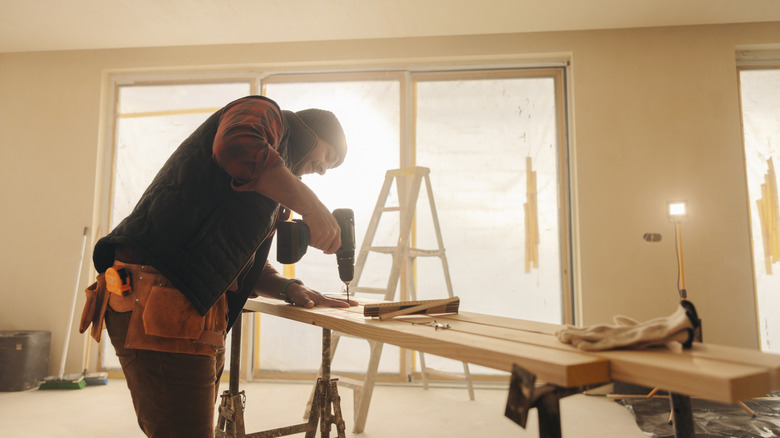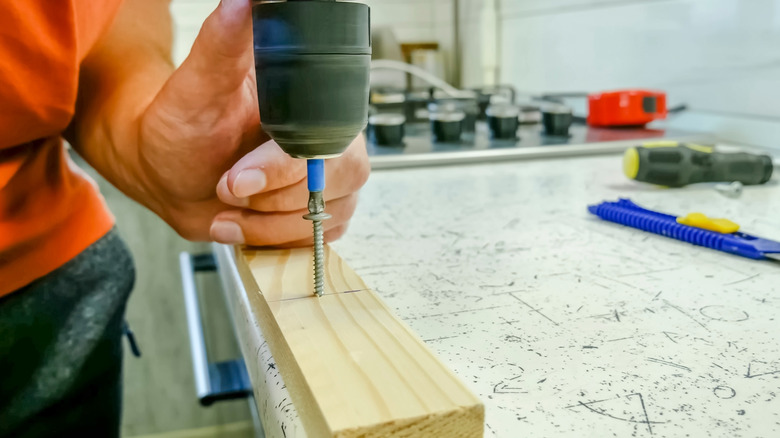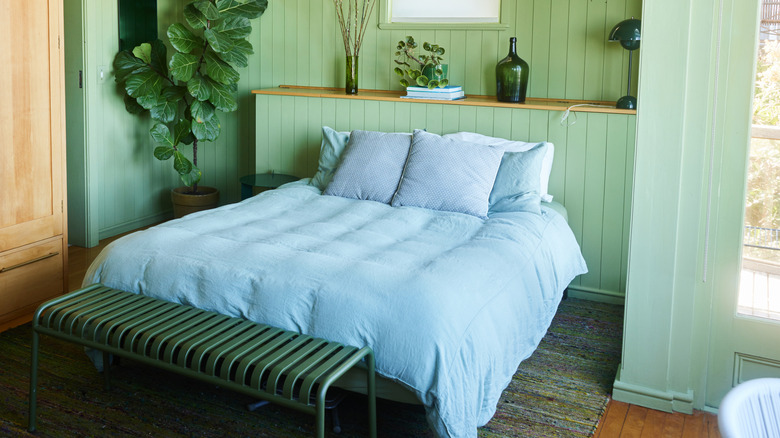DIY A Headboard Alternative For A Sleek, Minimalist Bedroom
We may receive a commission on purchases made from links.
You might spend hours picking out the perfect pillows, sheets, or blankets, but the right headboard is one often overlooked element that can make or break your bedroom. You may question if a headboard is really necessary, but it's more than just a decorative element. Headboards can also provide crucial back and head support. Since most of us spend about a third of our lives in bed, a well-designed headboard that incorporates shelving or storage capabilities can also help keep important items nearby. And if you're a big believer in the benefits of balance and flow, you'll be interested to learn that a headboard is the one bedroom item that you need to have for good Feng Shui. According to Bob Beacham, House Digest's expert carpenter and remodeler, it's quick and easy to DIY a bump-out headboard alternative for a sleek, minimalist bedroom.
Although there are countless statement headboards for your bedroom, from slat-covered walls to tufted options like the 24KF Linen Upholstered Headboard, House Digest asked Beacham how to build a three-dimensional mini wall using easily accessible materials like medium-density fiberboard (MDF) or plywood. "You need to decide the overall size first," he said during his exclusive interview. "A king-sized bed is 76 inches wide. A full sheet of plywood or MDF is usually 8x4." The carpentry expert said you'll need most of that full sheet for the front of your bump-out to avoid any unsightly joints. Along with a second sheet for the sides and top of your mini wall, Beacham also said you'll need 90-degree L brackets with two holes on each side, paint, and a little clear silicone to secure it firmly against your existing wall.
How to build your bump-out headboard
"I would make two simple frames using 1x1 lumber and 'L' brackets," Bob Beacham suggested during his exclusive interview with House Digest. He said to imagine the letter 'F' while constructing your frames. The main upright should support the front of your bump-out, while two additional horizontal ones should support the ends and top. "Four horizontal 1x1 rails would then run from each 'corner' or open end of one 'F' to the other," he explained. "Buy ¼-inch plywood and screw it to the frame, countersinking the heads." Fill and sand them to get a completely smooth finish.
Although you could use MDF to create the front, sides, and top of this headboard alternative, Beacham prefers working with plywood on projects of this nature. "MDF in particular is heavy," he cautioned. "An 8x4, ¾" sheet is around 90 pounds. It wouldn't be too difficult to pull the screws out of the MDF, and the whole thing would collapse." No matter which material you use, the carpenter said once it's constructed you shouldn't try to move your mini wall into place by yourself. "Get a friend to help you lift it carefully into position," he advised. The carpentry expert said you should continue to keep safety in mind after you've got your mini wall positioned exactly where you want it. "There are a couple of ways to address the potential tipping issue. You can buy anti-tip kits, but they aren't particularly attractive," he said. "You could fix a couple of small 'L' brackets to the sides of the headboard and then to the wall." And, adding a bead of clear silicone caulk along the rear support will act as glue to keep the headboard in place.
Things to consider before getting started
Along with taking careful measurements for the frame of your mini wall, there are some other things to consider before getting started with this DIY project. During his exclusive interview with House Digest, Bob Beacham said you should keep in mind that "if there was a baseboard, [your bump-out] wouldn't lie flat against the wall without that part at the bottom of the headboard being cut away to fit." This can be a real challenge, especially if your baseboards are sculpted or ornamental.
"You'll also have to consider how to put it in place," Beacham said. "Will you make it in the garage and then carry it to the bedroom, for example, or do you need to build it in situ?" The expert said that although MDF is stable and relatively easy to cut, "it doesn't hold screws particularly well though, especially under any kind of stress." He also cautioned that you should wear a mask and eye protection no matter which materials you use because there will be a lot of dust created during the process. Once you've finished building your new mini wall headboard, the last step is to customize it to match the style of your bedroom. "MDF is particularly easy to paint," He said. Plywood offers more options, because it can also be varnished, painted, or stained. You could also cover your bump-out with fabric, wallpaper, shiplap, or even tile.


